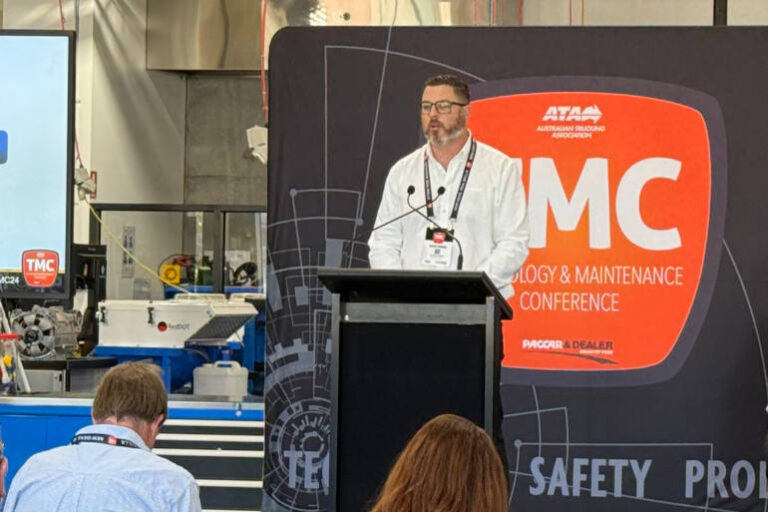The Australian Trucking Association’s Technology and Maintenance Conference (TMC), held in Melbourne in October, brought together key players in the trucking industry to discuss the future of vehicle technology. Shayne Commons, Director of Product and Performance at Volvo Group Australia, was a central speaker at the event. Commons shared insights on how technological advancements are shaping the trucking industry, particularly focusing on driver efficiency, safety, and environmental care.
Changing Landscape of Truck Technology
“Market and consumer demands are driving more advancements in truck technology,” Commons explained, emphasising that technology is no longer just about features and benefits but about its impact on drivers’ workspaces. He highlighted how this complexity is increasingly affecting drivers, operators, and fleet managers, requiring a deeper understanding of deployment, training, and usability.
Commons stressed that the speed of technological change is more rapid than ever. From electric vehicles to alternative drivetrains, the shift in truck technology involves not just adopting new systems but also building the infrastructure needed to support them. “It’s not only about understanding the deployment or suitability for your application or geographical location, but also about making sure the transition doesn’t disrupt operations,” he noted.
Importance of Driver Training and Adoption
A significant part of Commons’ presentation focused on the importance of education and training for drivers and operators to ensure the effective use of new technologies. As the complexity of in-vehicle technology increases, so does the need for tailored driver training.
“Vehicle training is crucial and must go beyond a general sales pitch. It needs to involve specific, complex training depending on vehicle configuration.”
To illustrate the challenges of technology adoption, Commons discussed the rollout of automated manual transmission (AMT) in the industry. Initially met with reluctance, AMT has now become standard in most vehicles due to its proven benefits, including improved efficiency, safety, and reduced driver fatigue. However, Commons pointed out that this shift required a change in driving style, highlighting the need for comprehensive driver training to ensure effective adaptation. “Each individual has a different learning style, so we must adapt our training to suit these needs,” Commons added.
Social Influences and Market Dynamics
Another key factor in technology adoption is social influence, which Commons described as pivotal in shaping market dynamics. He noted that drivers are increasingly connected through social media, influencing each other’s opinions and technology preferences. This social connection can significantly impact the adoption of new features. “We need to take advantage of these social influences to promote our products and get drivers to experience them firsthand,” Commons said.
To gain a better understanding of the factors influencing technology adoption, Volvo Group Australia commissioned a survey involving 600 participants, including 500 truck drivers and 100 company owners or operators. The survey aimed to identify key factors that impact the uptake of new technologies, with a focus on demographics such as age, gender, geographical location, and vehicle application.
Survey Insights: Key Features and Demographics
The survey results revealed interesting trends in technology preferences among different age groups. For example, reliability was the top priority for Baby Boomers (60-78 years old), whereas safety and efficiency were more important to younger drivers.
“Safety was less important to Baby Boomers, at 14%, while efficiency and reliability were both rated highly among younger generations,” Commons explained. This data helps manufacturers tailor technology features to meet the needs and preferences of diverse demographic groups.
The survey also highlighted the significant role that drivers play in influencing purchasing decisions. Many fleet owners and operators rely on drivers’ input to determine the adoption of new features, underscoring the importance of educating drivers about the benefits of new technologies.
“If we educate drivers about safety, efficiency, and productivity improvements, we can influence the next buying cycle,” Commons said.
Volvo’s Commitment to Innovation and Safety
Commons provided a historical perspective on Volvo’s technological innovations, tracing the evolution from the company’s inception in 1927 to the present. He emphasised that safety has always been a core focus, followed closely by environmental care. Notable milestones included the introduction of electronically controlled engines in 1980, the FH series cab in the 1990s, and the I-Shift transmission in 2001, which became a standard solution in 2018.
Commons pointed out that while early innovations were primarily mechanical, the pace of technological development has accelerated significantly since the introduction of electronic systems in the 1980s. The latest advancements include the launch of Volvo’s fully electric range and the Camera Monitoring System (CMS), which replaces traditional mirrors with high-resolution cameras to improve aerodynamics and visibility.
Balancing Innovation with Practicality
Despite the many benefits of new technologies, Commons acknowledged that not all features are suitable for every operation. For instance, while CMS offers clear advantages in certain applications, it may not be practical in all settings. “We need to work strategically with our partners to roll out these features effectively and provide the best possible education to the industry,” Commons said.
He also highlighted the difference between forced adoption (due to legal requirements) and voluntary adoption, which can significantly impact how quickly a new technology is embraced. The rollout of Euro 6 emissions standards in Australia, for example, involved a steep learning curve, particularly for operators in regional and rural areas where infrastructure is less developed.
Future Developments and the Road Ahead
Commons ended his presentation by teasing a new model launch, set to be unveiled in the coming weeks. Although details were scarce, he described it as an exciting addition to Volvo’s range. He also reiterated Volvo’s commitment to ongoing education and training for drivers and operators, noting that this is critical for successful technology adoption.
“Education is vitally important, and we know that as an OEM,” Commons concluded. He emphasised Volvo’s dedication to supporting both internal and external training initiatives, ensuring that new technologies are not only adopted but also embraced by the industry.






